NISSAN 370Z 2019 Owner´s Manual
Manufacturer: NISSAN, Model Year: 2019, Model line: 370Z, Model: NISSAN 370Z 2019Pages: 460, PDF Size: 2.26 MB
Page 51 of 460
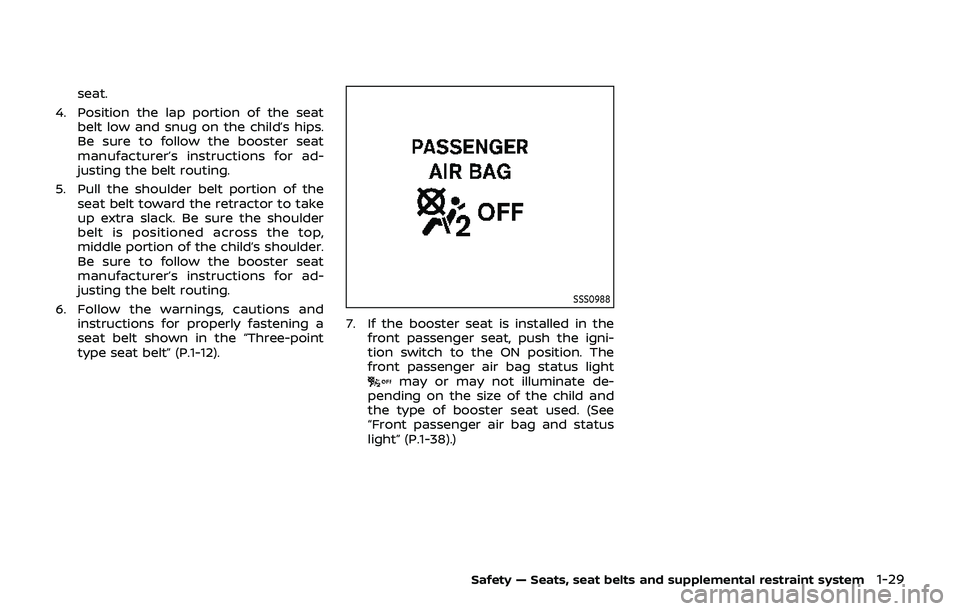
seat.
4. Position the lap portion of the seat belt low and snug on the child’s hips.
Be sure to follow the booster seat
manufacturer’s instructions for ad-
justing the belt routing.
5. Pull the shoulder belt portion of the seat belt toward the retractor to take
up extra slack. Be sure the shoulder
belt is positioned across the top,
middle portion of the child’s shoulder.
Be sure to follow the booster seat
manufacturer’s instructions for ad-
justing the belt routing.
6. Follow the warnings, cautions and instructions for properly fastening a
seat belt shown in the “Three-point
type seat belt” (P.1-12).
SSS0988
7. If the booster seat is installed in thefront passenger seat, push the igni-
tion switch to the ON position. The
front passenger air bag status light
may or may not illuminate de-
pending on the size of the child and
the type of booster seat used. (See
“Front passenger air bag and status
light” (P.1-38).)
Safety — Seats, seat belts and supplemental restraint system1-29
Page 52 of 460
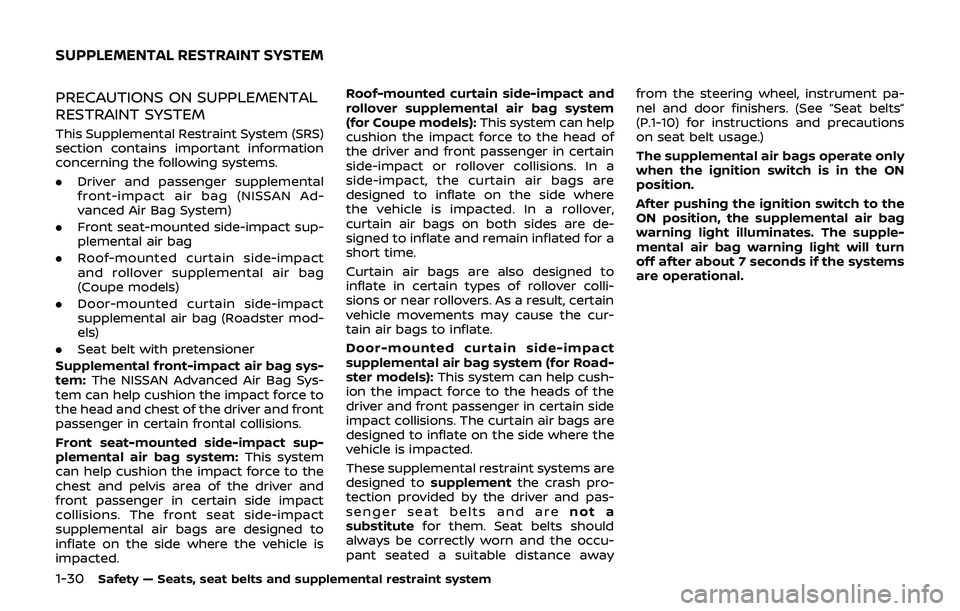
1-30Safety — Seats, seat belts and supplemental restraint system
PRECAUTIONS ON SUPPLEMENTAL
RESTRAINT SYSTEM
This Supplemental Restraint System (SRS)
section contains important information
concerning the following systems.
.Driver and passenger supplemental
front-impact air bag (NISSAN Ad-
vanced Air Bag System)
. Front seat-mounted side-impact sup-
plemental air bag
. Roof-mounted curtain side-impact
and rollover supplemental air bag
(Coupe models)
. Door-mounted curtain side-impact
supplemental air bag (Roadster mod-
els)
. Seat belt with pretensioner
Supplemental front-impact air bag sys-
tem: The NISSAN Advanced Air Bag Sys-
tem can help cushion the impact force to
the head and chest of the driver and front
passenger in certain frontal collisions.
Front seat-mounted side-impact sup-
plemental air bag system: This system
can help cushion the impact force to the
chest and pelvis area of the driver and
front passenger in certain side impact
collisions. The front seat side-impact
supplemental air bags are designed to
inflate on the side where the vehicle is
impacted. Roof-mounted curtain side-impact and
rollover supplemental air bag system
(for Coupe models):
This system can help
cushion the impact force to the head of
the driver and front passenger in certain
side-impact or rollover collisions. In a
side-impact, the curtain air bags are
designed to inflate on the side where
the vehicle is impacted. In a rollover,
curtain air bags on both sides are de-
signed to inflate and remain inflated for a
short time.
Curtain air bags are also designed to
inflate in certain types of rollover colli-
sions or near rollovers. As a result, certain
vehicle movements may cause the cur-
tain air bags to inflate.
Door-mounted curtain side-impact
supplemental air bag system (for Road-
ster models): This system can help cush-
ion the impact force to the heads of the
driver and front passenger in certain side
impact collisions. The curtain air bags are
designed to inflate on the side where the
vehicle is impacted.
These supplemental restraint systems are
designed to supplement the crash pro-
tection provided by the driver and pas-
senger seat belts and are not a
substitute for them. Seat belts should
always be correctly worn and the occu-
pant seated a suitable distance away from the steering wheel, instrument pa-
nel and door finishers. (See “Seat belts”
(P.1-10) for instructions and precautions
on seat belt usage.)
The supplemental air bags operate only
when the ignition switch is in the ON
position.
After pushing the ignition switch to the
ON position, the supplemental air bag
warning light illuminates. The supple-
mental air bag warning light will turn
off after about 7 seconds if the systems
are operational.
SUPPLEMENTAL RESTRAINT SYSTEM
Page 53 of 460
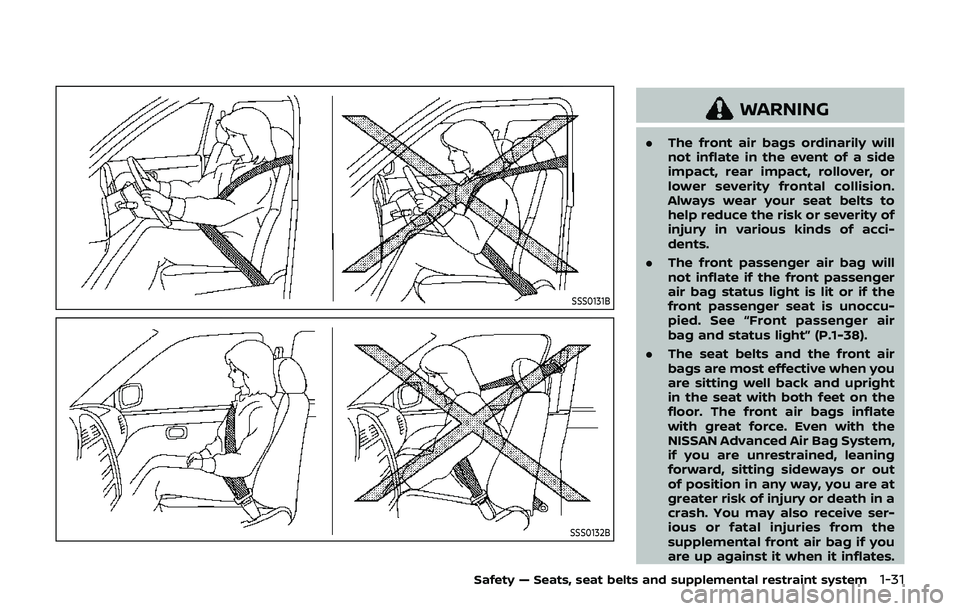
SSS0131B
SSS0132B
WARNING
.The front air bags ordinarily will
not inflate in the event of a side
impact, rear impact, rollover, or
lower severity frontal collision.
Always wear your seat belts to
help reduce the risk or severity of
injury in various kinds of acci-
dents.
. The front passenger air bag will
not inflate if the front passenger
air bag status light is lit or if the
front passenger seat is unoccu-
pied. See “Front passenger air
bag and status light” (P.1-38).
. The seat belts and the front air
bags are most effective when you
are sitting well back and upright
in the seat with both feet on the
floor. The front air bags inflate
with great force. Even with the
NISSAN Advanced Air Bag System,
if you are unrestrained, leaning
forward, sitting sideways or out
of position in any way, you are at
greater risk of injury or death in a
crash. You may also receive ser-
ious or fatal injuries from the
supplemental front air bag if you
are up against it when it inflates.
Safety — Seats, seat belts and supplemental restraint system1-31
Page 54 of 460
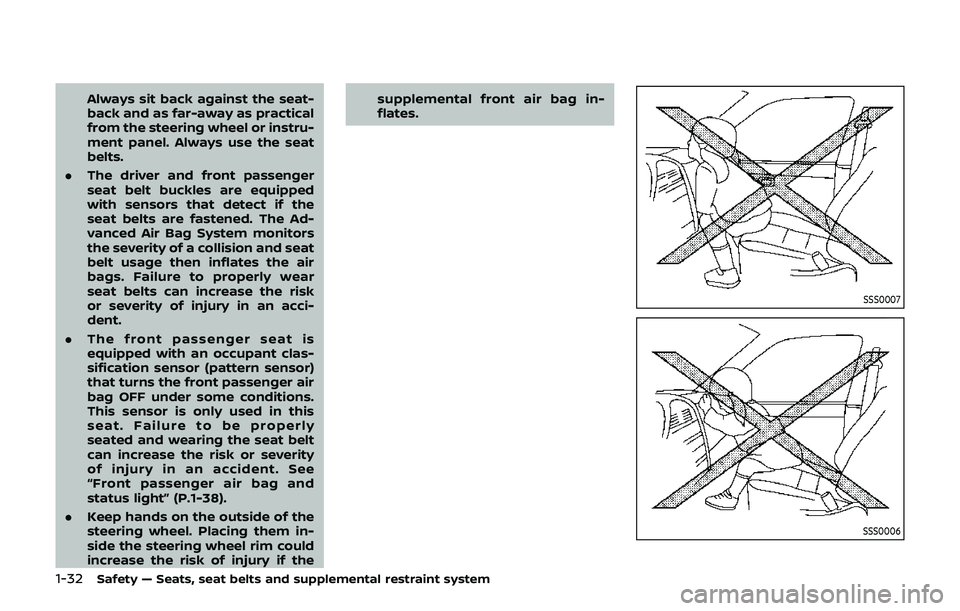
1-32Safety — Seats, seat belts and supplemental restraint system
Always sit back against the seat-
back and as far-away as practical
from the steering wheel or instru-
ment panel. Always use the seat
belts.
. The driver and front passenger
seat belt buckles are equipped
with sensors that detect if the
seat belts are fastened. The Ad-
vanced Air Bag System monitors
the severity of a collision and seat
belt usage then inflates the air
bags. Failure to properly wear
seat belts can increase the risk
or severity of injury in an acci-
dent.
. The front passenger seat is
equipped with an occupant clas-
sification sensor (pattern sensor)
that turns the front passenger air
bag OFF under some conditions.
This sensor is only used in this
seat. Failure to be properly
seated and wearing the seat belt
can increase the risk or severity
of injury in an accident. See
“Front passenger air bag and
status light” (P.1-38).
. Keep hands on the outside of the
steering wheel. Placing them in-
side the steering wheel rim could
increase the risk of injury if the supplemental front air bag in-
flates.
SSS0007
SSS0006
Page 55 of 460
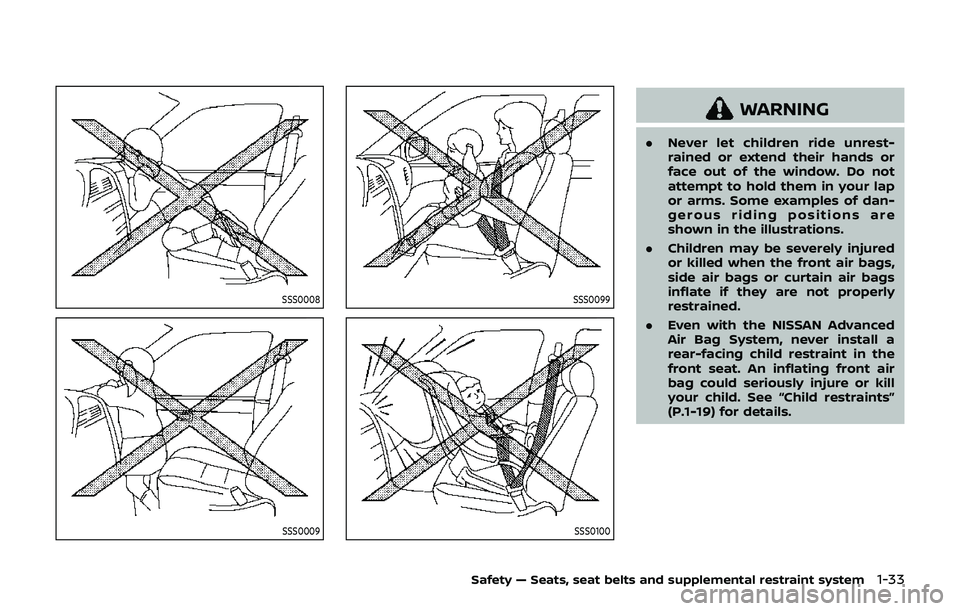
SSS0008
SSS0009
SSS0099
SSS0100
WARNING
.Never let children ride unrest-
rained or extend their hands or
face out of the window. Do not
attempt to hold them in your lap
or arms. Some examples of dan-
gerous riding positions are
shown in the illustrations.
. Children may be severely injured
or killed when the front air bags,
side air bags or curtain air bags
inflate if they are not properly
restrained.
. Even with the NISSAN Advanced
Air Bag System, never install a
rear-facing child restraint in the
front seat. An inflating front air
bag could seriously injure or kill
your child. See “Child restraints”
(P.1-19) for details.
Safety — Seats, seat belts and supplemental restraint system1-33
Page 56 of 460
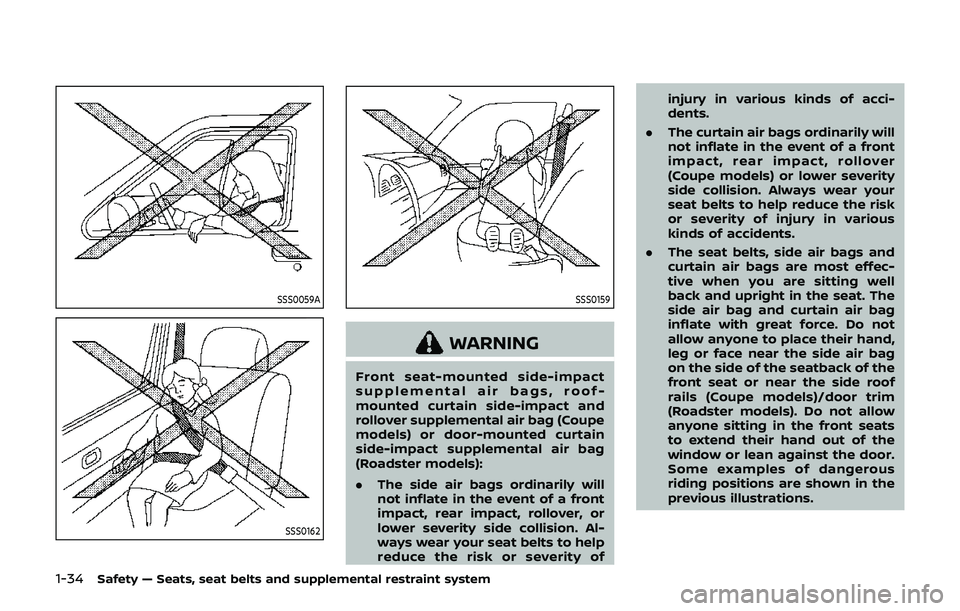
1-34Safety — Seats, seat belts and supplemental restraint system
SSS0059A
SSS0162
SSS0159
WARNING
Front seat-mounted side-impact
supplemental air bags, roof-
mounted curtain side-impact and
rollover supplemental air bag (Coupe
models) or door-mounted curtain
side-impact supplemental air bag
(Roadster models):
.The side air bags ordinarily will
not inflate in the event of a front
impact, rear impact, rollover, or
lower severity side collision. Al-
ways wear your seat belts to help
reduce the risk or severity of injury in various kinds of acci-
dents.
. The curtain air bags ordinarily will
not inflate in the event of a front
impact, rear impact, rollover
(Coupe models) or lower severity
side collision. Always wear your
seat belts to help reduce the risk
or severity of injury in various
kinds of accidents.
. The seat belts, side air bags and
curtain air bags are most effec-
tive when you are sitting well
back and upright in the seat. The
side air bag and curtain air bag
inflate with great force. Do not
allow anyone to place their hand,
leg or face near the side air bag
on the side of the seatback of the
front seat or near the side roof
rails (Coupe models)/door trim
(Roadster models). Do not allow
anyone sitting in the front seats
to extend their hand out of the
window or lean against the door.
Some examples of dangerous
riding positions are shown in the
previous illustrations.
Page 57 of 460
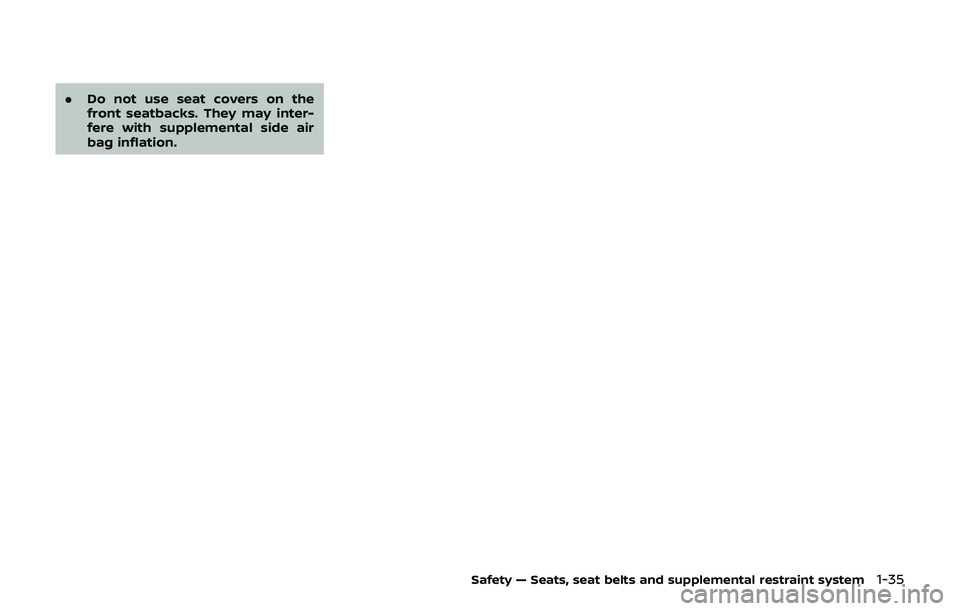
.Do not use seat covers on the
front seatbacks. They may inter-
fere with supplemental side air
bag inflation.
Safety — Seats, seat belts and supplemental restraint system1-35
Page 58 of 460
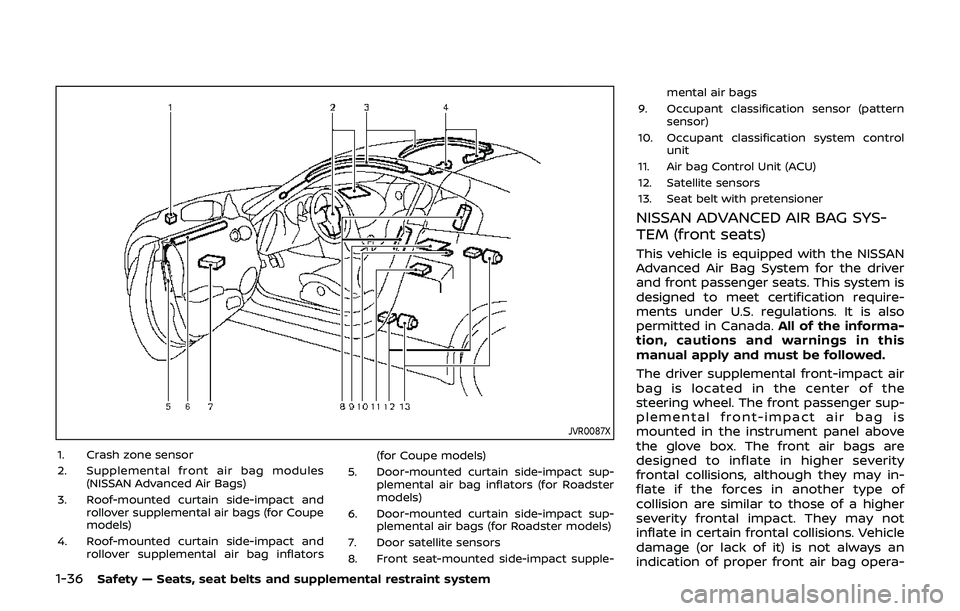
1-36Safety — Seats, seat belts and supplemental restraint system
JVR0087X
1. Crash zone sensor
2. Supplemental front air bag modules(NISSAN Advanced Air Bags)
3. Roof-mounted curtain side-impact and rollover supplemental air bags (for Coupe
models)
4. Roof-mounted curtain side-impact and rollover supplemental air bag inflators (for Coupe models)
5. Door-mounted curtain side-impact sup- plemental air bag inflators (for Roadster
models)
6. Door-mounted curtain side-impact sup- plemental air bags (for Roadster models)
7. Door satellite sensors
8. Front seat-mounted side-impact supple- mental air bags
9. Occupant classification sensor (pattern sensor)
10. Occupant classification system control unit
11. Air bag Control Unit (ACU)
12. Satellite sensors
13. Seat belt with pretensioner
NISSAN ADVANCED AIR BAG SYS-
TEM (front seats)
This vehicle is equipped with the NISSAN
Advanced Air Bag System for the driver
and front passenger seats. This system is
designed to meet certification require-
ments under U.S. regulations. It is also
permitted in Canada. All of the informa-
tion, cautions and warnings in this
manual apply and must be followed.
The driver supplemental front-impact air
bag is located in the center of the
steering wheel. The front passenger sup-
plemental front-impact air bag is
mounted in the instrument panel above
the glove box. The front air bags are
designed to inflate in higher severity
frontal collisions, although they may in-
flate if the forces in another type of
collision are similar to those of a higher
severity frontal impact. They may not
inflate in certain frontal collisions. Vehicle
damage (or lack of it) is not always an
indication of proper front air bag opera-
Page 59 of 460
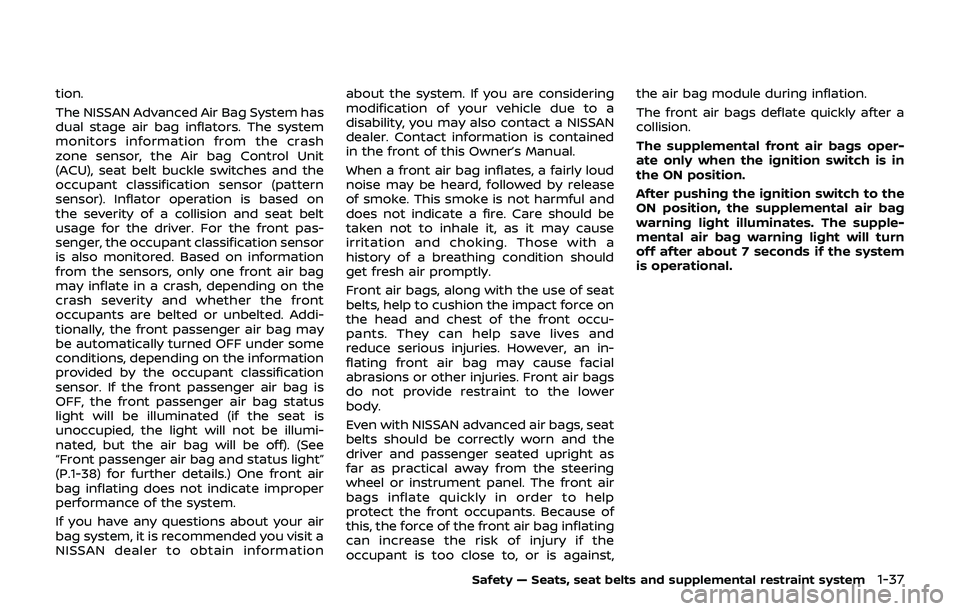
tion.
The NISSAN Advanced Air Bag System has
dual stage air bag inflators. The system
monitors information from the crash
zone sensor, the Air bag Control Unit
(ACU), seat belt buckle switches and the
occupant classification sensor (pattern
sensor). Inflator operation is based on
the severity of a collision and seat belt
usage for the driver. For the front pas-
senger, the occupant classification sensor
is also monitored. Based on information
from the sensors, only one front air bag
may inflate in a crash, depending on the
crash severity and whether the front
occupants are belted or unbelted. Addi-
tionally, the front passenger air bag may
be automatically turned OFF under some
conditions, depending on the information
provided by the occupant classification
sensor. If the front passenger air bag is
OFF, the front passenger air bag status
light will be illuminated (if the seat is
unoccupied, the light will not be illumi-
nated, but the air bag will be off). (See
“Front passenger air bag and status light”
(P.1-38) for further details.) One front air
bag inflating does not indicate improper
performance of the system.
If you have any questions about your air
bag system, it is recommended you visit a
NISSAN dealer to obtain informationabout the system. If you are considering
modification of your vehicle due to a
disability, you may also contact a NISSAN
dealer. Contact information is contained
in the front of this Owner’s Manual.
When a front air bag inflates, a fairly loud
noise may be heard, followed by release
of smoke. This smoke is not harmful and
does not indicate a fire. Care should be
taken not to inhale it, as it may cause
irritation and choking. Those with a
history of a breathing condition should
get fresh air promptly.
Front air bags, along with the use of seat
belts, help to cushion the impact force on
the head and chest of the front occu-
pants. They can help save lives and
reduce serious injuries. However, an in-
flating front air bag may cause facial
abrasions or other injuries. Front air bags
do not provide restraint to the lower
body.
Even with NISSAN advanced air bags, seat
belts should be correctly worn and the
driver and passenger seated upright as
far as practical away from the steering
wheel or instrument panel. The front air
bags inflate quickly in order to help
protect the front occupants. Because of
this, the force of the front air bag inflating
can increase the risk of injury if the
occupant is too close to, or is against,the air bag module during inflation.
The front air bags deflate quickly after a
collision.
The supplemental front air bags oper-
ate only when the ignition switch is in
the ON position.
After pushing the ignition switch to the
ON position, the supplemental air bag
warning light illuminates. The supple-
mental air bag warning light will turn
off after about 7 seconds if the system
is operational.
Safety — Seats, seat belts and supplemental restraint system1-37
Page 60 of 460
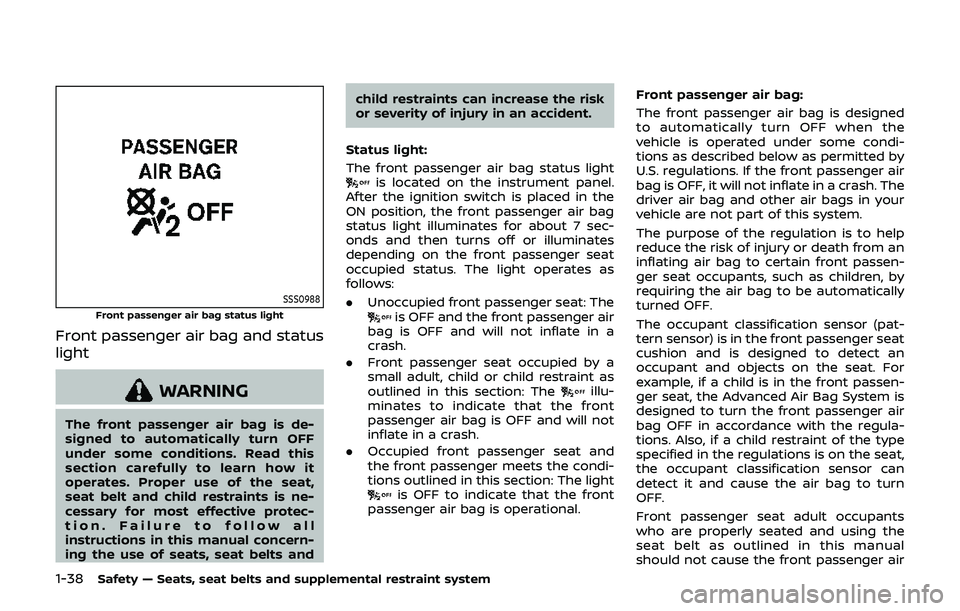
1-38Safety — Seats, seat belts and supplemental restraint system
SSS0988Front passenger air bag status light
Front passenger air bag and status
light
WARNING
The front passenger air bag is de-
signed to automatically turn OFF
under some conditions. Read this
section carefully to learn how it
operates. Proper use of the seat,
seat belt and child restraints is ne-
cessary for most effective protec-
tion. Failure to follow all
instructions in this manual concern-
ing the use of seats, seat belts andchild restraints can increase the risk
or severity of injury in an accident.
Status light:
The front passenger air bag status light
is located on the instrument panel.
After the ignition switch is placed in the
ON position, the front passenger air bag
status light illuminates for about 7 sec-
onds and then turns off or illuminates
depending on the front passenger seat
occupied status. The light operates as
follows:
. Unoccupied front passenger seat: The
is OFF and the front passenger air
bag is OFF and will not inflate in a
crash.
. Front passenger seat occupied by a
small adult, child or child restraint as
outlined in this section: The
illu-
minates to indicate that the front
passenger air bag is OFF and will not
inflate in a crash.
. Occupied front passenger seat and
the front passenger meets the condi-
tions outlined in this section: The light
is OFF to indicate that the front
passenger air bag is operational. Front passenger air bag:
The front passenger air bag is designed
to automatically turn OFF when the
vehicle is operated under some condi-
tions as described below as permitted by
U.S. regulations. If the front passenger air
bag is OFF, it will not inflate in a crash. The
driver air bag and other air bags in your
vehicle are not part of this system.
The purpose of the regulation is to help
reduce the risk of injury or death from an
inflating air bag to certain front passen-
ger seat occupants, such as children, by
requiring the air bag to be automatically
turned OFF.
The occupant classification sensor (pat-
tern sensor) is in the front passenger seat
cushion and is designed to detect an
occupant and objects on the seat. For
example, if a child is in the front passen-
ger seat, the Advanced Air Bag System is
designed to turn the front passenger air
bag OFF in accordance with the regula-
tions. Also, if a child restraint of the type
specified in the regulations is on the seat,
the occupant classification sensor can
detect it and cause the air bag to turn
OFF.
Front passenger seat adult occupants
who are properly seated and using the
seat belt as outlined in this manual
should not cause the front passenger air